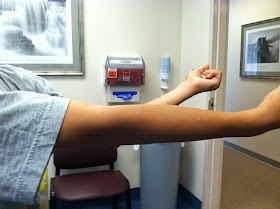The following case illustrates one of our patients who had an ATV injury and dislocated his elbow. He is 12 years old and was initially treated with closed reduction of elbow dislocation. The post reduction films demonstrated a displaced medial epicondyle fracture. The indication for fixation of this fracture is displacement of more than 5 mm. Our experience is that even the mildly displaced fractures with displace over time due to the pull of flexor pronator mass. Ulnar neuropathy is uncommon and was not seen in our case. The fracture was repaired with due 2 K Wires that were removed in the office 4 weeks after the surgery. Medial approach was used and the ulnar nerve was visualized and protected. After fixation intra-operative valgus stress was applied and no elbow instability was found
- technique considerations:
- ulnar nerve is identified and protected during exposure;
- K wires are used in young children, where as screws can be used in adolescents; We prefer K wires due to the fact that no hardware remains in the bone after removal
- flexor pronator mass and periosteum are repaired with sutures.
 |
| Dislocated elbow |
 |
| Postreduction films show elbow without dislocationa dn medial epicondyle fracture. Notice the medial epicondyle soft tissue swelling on the image on the Right. |
 |
| 4 weeks postop after fixation of the fracture with two medial K wires and immobilization in the long arm cast. |
 |
| 4 months postop the fracture is healed. |
 |
| 6 weeks after removal of the cast. |
 |
| 6 weeks after removal of the cast |
 |
| 4 months postop restoration of range of motion |
Further reading: http://www.ncbi.nlm.nih.gov/pubmed/15789012
